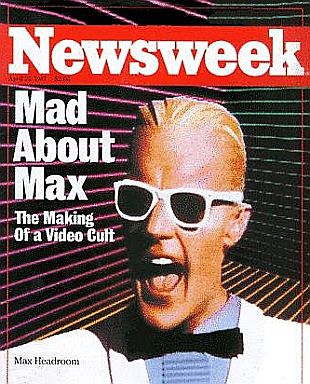The practice of using a spokesperson to promote a service or good isn't new. A spokesperson allows consumers to associate a trusted face with a product. I would think that being a spokesperson for a nationally-sold product is a good (and highly compensated) gig. The time it takes to reach "spokesperson" status varies but make one mistake and that opportunity is gone in a flash.
When I think about my personal awareness of spokespersons, the earliest example that comes to mind is Max Headroom. Maybe it was because he wasn't exactly human. Maybe it was because he was purposely targeting kids like me. No matter the reason, I was amazed by this futuristic promoter of New Coke. The fact that Max was everywhere - TV, magazine covers, games - made him even cooler. Access to information back then wasn't quite like it was today so I gave credit to The Coca-Cola Company for developing such a unique character. It was only until recent years that I learned that Max had a lot going for himself before Coke came calling.
 |
| Newsweek - April 1987 |
- Max’s first appearance came in a 1985 British TV film titled, Max Headroom: Twenty Minutes into The Future. The character of Max was a hit and he was made part of a British music video show (remember those?) that same year.
- America caught wind of Max’s popularity and he was given his own show on Cinemax in 1986. The series (titled Max Headroom) was based on the original film.
- In 1986 and through 1987, Max was tapped to be the face of New Coke as The Coca-Cola Company scrambled to develop a separate campaign that promoted Coca-Cola Classic, which had to be created in response to the negative reception of New Coke. The Coca Cola Company probably couldn't simply scratch New Coke entirely and Max was a great fit. If there’s anything I remember about New Coke, it’s definitely Max's "C-c-c-catch the Wave" slogan.
- Max's popularity peaked in 1987. His likeness was featured on t-shirts, posters, toys - you name it. Even a Max Headroom mask made an appearance in one of the more significant incidences in broadcast television history. A small group of people that had the intelligence and equipment needed to interrupt the signals of Chicago-based WGN did so on November 22, 1987. This recent article from Wired recapped the incident and you can watch the video for yourself on YouTube. It's one of the eeriest videos I've seen on YouTube. The hijack itself was scary as it exposed the vulnerability of broadcast signals at the time.
LIFE AFTER NEW COKE
New Coke may have been a flop but it opened more doors for Max. He was the subject of another TV show in 1987, this time on a major network - ABC. And get this: Max also was the host of a talk show on Cinemax in which he conducted interviews with celebrities of the day. Unfortunately, the shows weren't popular and big portion of Max's visibility took a hit as The Coca-Cola Company worked to turn New Coke into a fading memory.
My search to find elements of Max Headroom's "work" after 1987 came up empty. The only noticeable example I came across a series of creative ads that aired in 2007 informed viewers in Britain about the upcoming switch to a digital broadcast signal.
MAX'S IMPACT ON SPOKESPERSONS
Arguments can be made for using characters or real people as your spokesperson. Real people, like Bill Cosby, have a history of letting you down. Sure, the actress may run afoul but we'll never see news reports about the legal troubles of Flo from Progressive.
I realize that you lose heat-of-the-moment recognition when taking a conservative approach to selecting a spokesperson but Max Headroom showed that it's possible to make a lasting impact without the risk of human flaws creating drama for your company.


No comments:
Post a Comment